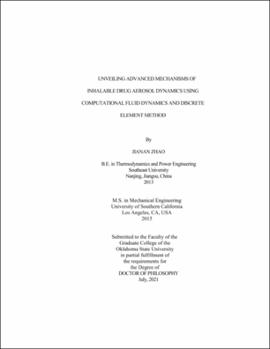| dc.contributor.advisor | Feng, Yu | |
| dc.contributor.author | Zhao, Jianan | |
| dc.date.accessioned | 2022-01-21T19:20:07Z | |
| dc.date.available | 2022-01-21T19:20:07Z | |
| dc.date.issued | 2021-07 | |
| dc.identifier.uri | https://hdl.handle.net/11244/333784 | |
| dc.description.abstract | Capsule-based dry powder inhalers (DPIs) are widely used to treat chronic obstructive pulmonary disease (COPD) by delivering active pharmaceutical ingredients (APIs) via inhalation into human respiratory systems. Previous research has shown that the actuation flow rate, aerodynamic particle size distribution (APSD), and particle shape of lactose carriers are factors that can influence the particle deposition patterns in human respiratory systems. Understanding the dynamics of APIs transport in DPIs and airways can provide significant value for the design optimization of DPIs and particle shapes to enhance the delivery of APIs to the designated lung sites, i.e., small airways. Thus, it is necessary to investigate how to modulate the above-mentioned factors to increase the delivery efficacy to small airways and enhance the therapeutic effect to treat COPD. Compared with in vitro and in vivo methods, computational fluid-particle dynamics (CFPD) models allow researchers to study the transport dynamics of inhalable therapeutic dry powders in both DPI and human respiratory systems. However, existing CFPD models neglect particle-particle interactions, and most existing airway models lack peripheral lung airway and neglect the airway deformation kinematics. Such deficiencies can lead to inaccurate predictions of particle transport and deposition. This study developed a one-way coupled computational fluid dynamics (CFD) and discrete element method (DEM) model to simulate the particle-particle and particle-device interactions, and the transport of API-carrier dry powder mixtures with different shapes of carriers in a DPI flow channel. The influence of actuation flow rate (30 to 90 L/min) and particle shape (aspect ratio equals 1, 5, and 10) on lactose carrier dynamics in a representative DPI, i.e., SpirivaTM HandihalerTM, has been investigated. Subsequently, an elastic truncated whole-lung model has also been developed to predict particle transport and deposition from mouth to alveoli, with disease-specific airway deformation kinematics. Numerical results indicate that 90 L/min actuation flow rate generates the highest delivery efficiency of Handihaler, as approximately 26% API reaches the deep lung region. The elastic truncated whole-lung modeling results show that noticeable differences of predictions between static and elastic lung models can be found, which demonstrates the necessity to model airway deformation kinematics in virtual lung models. | |
| dc.format | application/pdf | |
| dc.language | en_US | |
| dc.rights | Copyright is held by the author who has granted the Oklahoma State University Library the non-exclusive right to share this material in its institutional repository. Contact Digital Library Services at lib-dls@okstate.edu or 405-744-9161 for the permission policy on the use, reproduction or distribution of this material. | |
| dc.title | Unveiling advanced mechanisms of inhalable drug aerosol dynamics using computational fluid dynamics and discrete element method | |
| dc.contributor.committeeMember | Ford Versypt, Ashlee N. | |
| dc.contributor.committeeMember | Shah, Jindal | |
| dc.contributor.committeeMember | Santhanakrishnan, Arvind | |
| osu.filename | Zhao_okstate_0664D_17338.pdf | |
| osu.accesstype | Open Access | |
| dc.type.genre | Dissertation | |
| dc.type.material | Text | |
| dc.subject.keywords | aerosol dynamics | |
| dc.subject.keywords | computational fluid particle dynamics | |
| dc.subject.keywords | discrete element method | |
| dc.subject.keywords | dry powder inhaler | |
| dc.subject.keywords | elastic truncated whole-lung model | |
| dc.subject.keywords | human respiratory system | |
| thesis.degree.discipline | Chemical Engineering | |
| thesis.degree.grantor | Oklahoma State University | |
